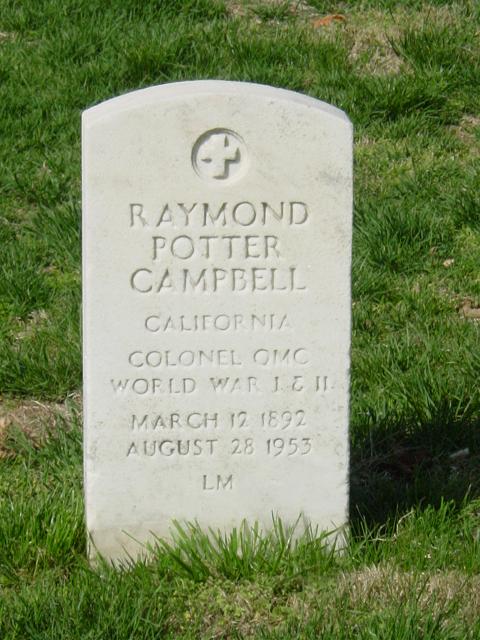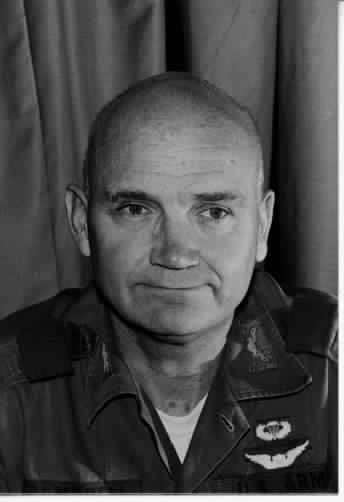R. Potter Campbell Jr. was born on December 27, 1918, in Llewellyn Park, New Jersey — an auspicious start for the Campbell clan. As the son of Colonel (USMA ’16) Raymond Potter Campbell and Katherine Browning Campbell, he grew up playing with the grandchildren of his neighbor Thomas Edison, the inventor. Always a creative and adventurous soul, he spent his early life doing such novel things as painting (e.g. his parents house with baby formula), canoeing down the Tamiami River in Maine, and riding horses in the Montclair Mounted Troop.
His teenage years were spent in New Hampshire where he graduated from Phillips Exeter academy in 1936. As one of his dearest friends said, “he was a true Exonian in every sense, living his life by one of Exeter’s core values: Non Sibi — not for oneself.” This philosophy guided his footsteps — and his life — as he followed his father to West Point.
After a stimulating and rigorous four years at USMA, Potter was ready to take on the world. Possibly influenced by his years on horseback, Cavalry (later to become Armor) was his branch of choice. He was successively assigned to the 4th, 5th, 8th and 11th Armored Divisions. During the same time, unknown to him, Betty Brooks (daughter of the CG of the 11th AD in Fort Knox – General Edward Hale Brooks) saw his picture in the Howitzer and said she “liked his face.” Little did Potter know the importance of that comment. Before he could gallop off into the sunset, he met Betty and, after a whirlwind courtship, asked her to marry him. Later when asked how she met Potter she would say, “well, you know, I picked him out of the catalog.” Their wedding on Feb. 14, 1942, began a wonderful, warm, and loving partnership lasting 55 years.
Not ones to waste any time, over the next two years Betty and Potter worked on developing the Campbell clan, beginning with the births of daughters Nancy in November 1942 and Beatrice (Bebe) in May 1944. With a child under each arm, in 1944 they left the 11th AD for the Naval War College in Newport, where Potter was the youngest and most junior officer to graduate from Senior Command course. (26, Major) From Newport it was back to Army assignments, the 13th AD, which reached Normandy just in time to help chase the Wehrmacht into Austria. The atomic bomb saved his division from having to lead the way in the invasion of Japan.
1944 to 1946 saw the family in Philadelphia where Potter got his MS in Electrical Engineering at the University of Pennsylvania. Clan expansion also continued with the birth of Katherine (Kitty) in August 1946. In 1948, they trekked with three beautiful daughters in tow to Albuquerque where, by 1950, Potter was the XO of the 8460th Special (read Atomic) Weapons Group at Sandia Base. Despite a demanding schedule, Potter always found time to spend with his growing family — hiking in the Sandia Mountains, and gathering horny toads and guinea pigs as they escaped from the clutches of his children. Highlighting this tour was the birth of a son, Brooks, in August 1950 to round out the clan.
From New Mexico, Potter was transferred to Washington, D.C. where he was the #3 man in the Atomic Energy Commission’s Weapons Test Division. During three years there, he was responsible for supervising the bases and the weapons for the atomic weapons test series in Nevada and Eniwetok. From the AEC, he was sent to Korea in 1953 to command the 89th Tank Battalion, later fictionalized in the “Brotherhood of War” book series as a leading the breakout from Pusan (done before his time).
The division was transferred to Hawaii in 1954 where the Campbell clan joined Potter for two wonderful years. A great place for children, its enchantment was enhanced by Potter’s love of exploration and adventure. None of the family will ever forget the trip to the Kilauea volcano on the big Island, his showing them Pele’s diamonds in the crater and playing with the baby wild pigs in the camp. Even more exciting was their foray to the beach to “see the ocean during a hurricane.” The children vividly recalled pushing the old Ford with Potter in the driving rain, knee deep in mud and red ants, as Betty and Brooks popped the clutch to get them to solid land. As one of his friends said, “… he had a wonderful sense of humor and a tremendous interest in a wide variety of subjects!”
With mixed emotions, they left Hawaii in 1956 to come the full circle, back to the Cavalry Plain at USMA, where Potter commanded the Armor Detachment. 1959 saw them off to Carlisle, and Potter’s second War College. Selected for the Army Aviation Senior Officer Program thereafter, he got his wings in 1960 at the Aviation School and was kept on afterwards as a department head and, briefly, as Assistant Commandant. He also served on the staff of the Howze Board, which developed the airmobile concept. Sent to Washington, D.C., in 1963, he was assigned to DDR&E/OSD, with staff responsibility in the Directorate for Army Aviation input into the inventory and force structure.
Transferred to Vietnam in 1966, he was given command of the new 12th Aviation Group in the 1st Aviation Brigade — and, as he said, “an unforgettable unbeatable tour among top-notch people.” During his 27 years in the Army Potter was awarded many medals, among which were 2 Legions of Merit, the Distinguished Flying Cross, the Bronze Star Medal of Valor, the Bronze Star, and the Air Medal for Valor.
Following Vietnam things seemed anticlimactic for Potter, so in 1968, after 37 moves with the Army, he accepted a fine offer from his old DDR&E boss to come to work at Grumman Aerospace Corp. and live on Long Island. He worked very hard there for nine years, while spending his leisure hours racing big sailboats on Long Island Sound.
In 1977, with Brooks through college, Betty and Potter retired (again) to 17 acres of woodland on a gorgeous lake in New Hampshire where Potter began his third career within the community. Once again Potter proved himself the consummate leader. Calm, capable, and confident — assisted by Betty who shared his interest in people and civic affairs — Potter served as Chairman of the Huggins Hospital Street Fair and as President of the Abenaki Tower and Trail Association. But he is best known as President of the Tuftonboro Association from 1987 to 1995. He took an organization much in need of revitalization at that time and infused into it new life, energy, and vision. The projects he initiated will positively influence the quality of life in the surrounding area for generations to come. As one co-worker said, “(Potter) has always been known as a man alert to areas of need and capable of focus to the finish.”
Always a family man — even in the military preferring home to the Officer’s Club — he loved children, gave 4th of July parties for them, and was a substitute Girl Scout “den mother”. He adored his grandchildren. It was his stated goal to be as wonderful a grandfather as was his own grandfather, Charles Ross Browning, from whom he took the moniker “Bop”. His grandchildren can verify that he succeeded, and how. It was while playing with these grandchildren — after tobogganing with his usual game spirit — that Potter took the fatal fall that would suddenly end a life of action and involvement. He was a caring, giving, doing man who made each of us feel special — a modest man and consummate gentleman with a real concern for others, with a twinkle in his eye, a chuckle, and a wry remark or two about the world at-large. He embodied that rare combination of an intellectual with a keen sense of humor — a man who loved his family and his country and who was always there with hugs. He is greatly missed by all.
Colonel Campbell lies at rest in Section 30 of Arlington National Cemetery.
The Colonel’s father, Raymond Potter Campbell, Colonel, United States Army, is buried adjacent to him in Arlington National Cemetery.
CAMPBELL, RAYMOND POTTER Jr
COL US ARMY
WORLD WAR II, KOREA, VIETNAM
- DATE OF BIRTH: 12/27/1918
- DATE OF DEATH: 02/09/1997
- BURIED AT: SECTION 30 SITE 1071 RH
ARLINGTON NATIONAL CEMETERY
Michael Robert Patterson was born in Arlington and is the son of a former officer of the US Army. So it was no wonder that sooner or later his interests drew him to American history and especially to American military history. Many of his articles can be found on renowned portals like the New York Times, Washingtonpost or Wikipedia.
Reviewed by: Michael Howard


